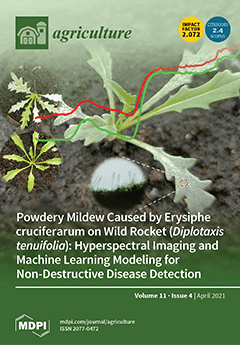Rice sheath blight, a fungal disease caused by
Rhizoctonia solani, seriously threatens rice production. Some of the volatile organic compounds (VOCs) produced by microbes are inhibitory to the growth of the plant pathogen, and hence may have the potential as environmentally friendly
[...] Read more.
Rice sheath blight, a fungal disease caused by
Rhizoctonia solani, seriously threatens rice production. Some of the volatile organic compounds (VOCs) produced by microbes are inhibitory to the growth of the plant pathogen, and hence may have the potential as environmentally friendly antifungal substances. However, information on the inhibitory effect of VOCs released by rice rhizosphere bacteria on
R. solani is scarce. In this study, bacteria from the rice rhizosphere capable of inhibiting the growth of
R. solani via releasing VOCs were screened using a double Petri dish assay. Headspace solid phase microextraction and gas chromatography mass spectrometry (GC/MS) were used to identify and quantify the VOCs. The contributions of VOCs to the inhibition of the growth of
R. solani were estimated by constructing a random forest model, and were verified using pure compounds. Nine strains (i.e.,
Pseudomonas sp. No. 3,
Enterobacter sp. No. 26,
Enterobacter sp. No. 34,
Pseudomonas sp. No. 35,
Ralstonia sp. No. 50,
Bacillus sp. No. 62,
Arthrobacter sp. No. 146,
Brevibacillus sp. No. 2–18, and
Paenisporosarcina sp. No. 2–60) showed various inhibition on
R. solani growth via VOCs. The inhibitory effect ranged from 7.84% to 100%, with
Ralstonia sp. No. 50 completely inhibiting the growth of
R. solani. Five VOCs (i.e., benzoic acid ethyl ester, 3-methyl-butanoic acid, 2-ethyl-1-hexanol, 3-methyl-1-butanol, and 6-methyl-5-hepten-2-one) identified by random forest model were confirmed to be toxic to
R. solani when applied as a pure chemical compound. In particular, benzoic acid ethyl ester, 3-methyl-butanoic acid, and 2-ethyl-1-hexanol were lethal to
R. solani. In summary, the rice rhizosphere bacteria (
Ralstonia sp. No. 50) and VOCs (benzoic acid ethyl ester, 3-methyl-butanoic acid, and 2-ethyl-1-hexanol) showed potential to be used as new resources for biological control of rice sheath blight.
Full article





